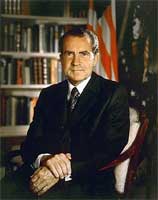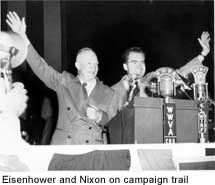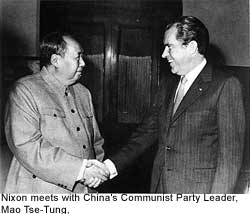 Richard Milhous Nixon, the thirty-seventh President of the United States (1969-74) became President in 1969 after defeating Lyndon Johnson's Vice-President, Hubert Humphrey, in one of the closest elections in US history. Nixon won that election by only one percent of the popular vote. Nixon was the second youngest Vice President and the first Californian to serve in the White House. He was also the first Vice President to be elected President, but not to succeed the President under whom he had served. He was also the first President to resign the presidency, which he did after the House Judiciary Committee voted articles of impeachment against him in 1974. Richard Nixon was a controversial President, nicknamed "Tricky Dick" and demonized by some, while admired by others for his accomplishments. Richard Milhous Nixon, the thirty-seventh President of the United States (1969-74) became President in 1969 after defeating Lyndon Johnson's Vice-President, Hubert Humphrey, in one of the closest elections in US history. Nixon won that election by only one percent of the popular vote. Nixon was the second youngest Vice President and the first Californian to serve in the White House. He was also the first Vice President to be elected President, but not to succeed the President under whom he had served. He was also the first President to resign the presidency, which he did after the House Judiciary Committee voted articles of impeachment against him in 1974. Richard Nixon was a controversial President, nicknamed "Tricky Dick" and demonized by some, while admired by others for his accomplishments.

Born on January 9, l913 in Yorba Linda, California into a modest Quaker family, he spent his youth working hard and studying. A brilliant scholar, Dick Nixon graduated second in his class from Whittier College (1934), then third in his class from Duke University Law School (1937). Nixon practiced law in his hometown in Whittier, CA from 1937 to 1942. In l940, he married Thelma "Pat" Ryan.

In 1942, Nixon joined the United States Navy where he served as a supply officer in the South Pacific during World War II. He left the service as a Lieutenant Commander. Back in Whittier in 1946, Nixon entered the political arena. He challenged Democratic congressman Jerry Voorhis. Nixon campaigned vigorously, and won by 16,000 votes.
 In 1948 and 1949, Nixon obtained national recognition while serving in the United States House of Representatives as a member of the Committee on Un-American Activities. He was dogged in his support for the investigation of Alger Hiss. Although Hiss was a former State Department official who had served as the President of the Carnegie Endowment for International Peace, he was found guilty of helping to transmit confidential government documents - called the "Pumpkin Papers" because they were hidden in a pumpkin -- to the Soviets. Nixon again used anti-communism to his advantage when, in 1950, he ran for the United States Senate against Congresswoman Helen Gahagan Douglas, a popular liberal Democrat. By dubbing her the "Pink Lady," he cast aspersions on her loyalty without actually accusing her of being a Communist. Although he won the election, his campaign tactics were widely criticized. Nevertheless, he became the bright young star in the Republican Party. In 1948 and 1949, Nixon obtained national recognition while serving in the United States House of Representatives as a member of the Committee on Un-American Activities. He was dogged in his support for the investigation of Alger Hiss. Although Hiss was a former State Department official who had served as the President of the Carnegie Endowment for International Peace, he was found guilty of helping to transmit confidential government documents - called the "Pumpkin Papers" because they were hidden in a pumpkin -- to the Soviets. Nixon again used anti-communism to his advantage when, in 1950, he ran for the United States Senate against Congresswoman Helen Gahagan Douglas, a popular liberal Democrat. By dubbing her the "Pink Lady," he cast aspersions on her loyalty without actually accusing her of being a Communist. Although he won the election, his campaign tactics were widely criticized. Nevertheless, he became the bright young star in the Republican Party.
In 1952, when Nixon was nominated to be Dwight Eisenhower's running mate, he was only thirty-nine years old. It was soon exposed that Nixon had accepted $18,000 for political expenses and Eisenhower's advisors wanted Nixon to resign. He responded with a brilliant speech that (because of a sentimental reference to his dog) became known as the "Checkers Speech." It saved his political career.
Eisenhower and Nixon won the election defeating the Democrat Adlai Stevenson by over 6,000,000 votes. Although during the Eisenhower years, the relationship between the President and Vice President was somewhat strained, years later Nixon's youngest daughter, Julie, married Eisenhower's grandson, David, for whom the Presidential retreat, Camp David, is named.
Eisenhower and Nixon won easily in the 1956 election. As Vice President, Nixon became a vigorous Republican spokesman. In non-election years, he traveled the country trying to raise money for the party. He also achieved foreign affairs credentials by visiting numerous other countries, including the Soviet Union, where In 1959, Nixon, the anti-Communist, opened the American Exhibit in Russia. While escorting the Soviet leader through a model of an American house, an impromptu "kitchen debate" with Nikita Khrushchev made world-wide headlines. In an effort to make a strong point, Krushchev took off his shoe and banged it on the table.
As undisputed party leader, Nixon easily won the Presidential nomination in 1960. That was the year of the first televised Presidential debates, and some say Nixon's appearance put him at a disadvantage next to the young, charismatic Jack Kennedy, who won the presidency, but just barely. Out of the 70 million votes cast, JFK received a mere 113,000 more than Nixon did.
In 1962 Nixon went up against the popular Pat Brown for Governor of California. He lost that election and afterward bitterly attacked the press, saying "You won't have Dick Nixon to kick around any more." Many felt it was the end of his career. Not so. He was again nominated in l968, when he and running mate, Spiro Agnew, won the White House by 500,000 votes.

 Richard Nixon's main interest had long been international affairs. After being elected President in 1968, he traveled to China and also established détente with the USSR. Perhaps his greatest achievement was opening lines of communication and trade with the People's Republic of China. Realizing the time was right for such a move, he sent a representative to secretly consult with the Chinese Premier, Mao Tse Tung, in 1971 and met with him himself in 1972. This diplomatic success amazed the critics. Within weeks of his successful China trip, Nixon was in Moscow negotiating the Strategic Arms Limitations Agreement (SALT) to reduce the chance of nuclear war. Nixon also established links with Egypt and Israel. Richard Nixon's main interest had long been international affairs. After being elected President in 1968, he traveled to China and also established détente with the USSR. Perhaps his greatest achievement was opening lines of communication and trade with the People's Republic of China. Realizing the time was right for such a move, he sent a representative to secretly consult with the Chinese Premier, Mao Tse Tung, in 1971 and met with him himself in 1972. This diplomatic success amazed the critics. Within weeks of his successful China trip, Nixon was in Moscow negotiating the Strategic Arms Limitations Agreement (SALT) to reduce the chance of nuclear war. Nixon also established links with Egypt and Israel.
Back in the United States, he adopted a program called the "New Federalism", which was supposed to end the habit of "throwing money at problems." He reversed many of the social and economic welfare programs of his predecessor; Lyndon Johnson. On racial matters Nixon adopted a passive stance toward efforts by African American to achieve educational, economic, and social equality, and he responded to the rising crime rate by demanding stricter law enforcement. The Nixon administration was plagued by economic problems that led to the imposition of wage and price controls in 1971. During his tenure in the White House, oil prices quadrupled.
 Nixon's biggest problem on both the international and domestic fronts was the War in Vietnam. He had campaigned to end it, and began withdrawing some of the troops, calling for the "Vietnamization" of the War. At the same time, however, he escalated the bombings and in 1970 authorized the invasion of Cambodia. The following year he committed American troops to assisting in a South Vietnamese invasion of Laos. At home the campuses were exploding, and demonstrations against the war were a daily affair. Nixon's biggest problem on both the international and domestic fronts was the War in Vietnam. He had campaigned to end it, and began withdrawing some of the troops, calling for the "Vietnamization" of the War. At the same time, however, he escalated the bombings and in 1970 authorized the invasion of Cambodia. The following year he committed American troops to assisting in a South Vietnamese invasion of Laos. At home the campuses were exploding, and demonstrations against the war were a daily affair.
Nevertheless, in the election of 1972 Nixon and Agnew, were easily reelected in a landslide victory over George McGovern. Shortly after this election, Nixon was accused of irregularities and illegalities conducted on his behalf in a scandal that became known as Watergate. An attempted burglary and wire-tapping of the office of the Democratic National Committee in the Watergate complex had been traced back to men hired by some of the President's closest advisors. The media eventually exposed a much larger picture of political corruption. Illegal contributions, "dirty tricks", as well as irregularities in Nixon's income taxes where uncovered, and public trust dropped drastically. This overshadowed the fact that on January 28, 1973, a cease fire agreement went into effect. After years of bloodshed, Nixon and his secretary of state, Henry Kissinger, had finally been able to end the Vietnam War.
Nixon's Vice President, Spiro Agnew, had been forced to resign in 1973 after pleading "no contest" to charges of income tax evasion. He was replaced by Gerald Ford. Before the Watergate investigation was over, all but one of Nixon's aides were forced to resign. In March of 1974, a federal grand jury named the President as an unindicted coconspirator in an attempt to obstruct justice in the Watergate investigation. The House Judiciary Committee began to investigate the case for impeachment. The United States Supreme Court would not allow Nixon to claim Executive Privilege in order to avoid prosecution. Ultimately, The Judiciary Committee recommended impeachment to the full House of Representatives. Rather than face trial, on August 9, 1974, Richard Nixon became the first American President ever to resign from office. At noon on that same day, as Nixon was being flown to his retirement in California, Gerald Ford took the Oath of Office. The newly elected President granted Nixon a full pardon.

Upon his withdrawal from the American political arena, Dick Nixon turned to lecturing and writing until his death on April 22, 1994, shortly after the opening of his presidential library in Yorba Linda California.
|

